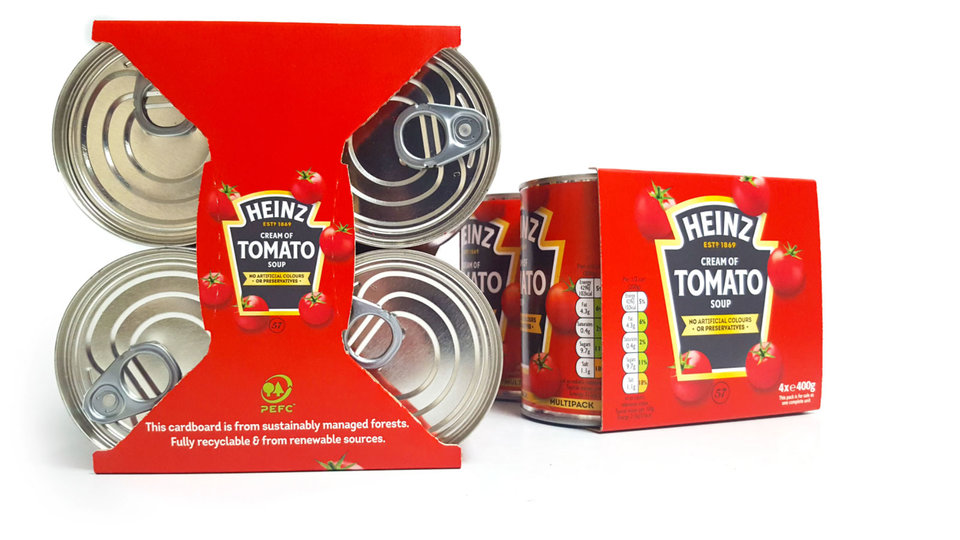Cardboard
From plastic to cardboard - How to make the switch
Phasing out plastic in preference of more sustainable materials for packaging is a popular direction of travel among FMCG companies the world over - so much so that it’s becoming a stampede. In September, for example, the UK division of food giant Kraft Heinz Co made the move to recyclable paperboard for its tinned multipacks in the country.

I
nside Packaging’s Jessica Paige spoke with Kraft Heinz’s brand manager for soups, Anke Von Hanstein, and Mark Shaw, the business leader for EMEA & APAC at corrugated packaging producer WestRock, to hear more about making the move from plastic to cardboard.
Inside Packaging: Why did you make the decision to switch?
Anke Von Hanstein: Our aim at Heinz is to make 100% of our packaging recyclable, reusable or compostable by 2025. This prompted us to review our use of traditional plastic shrink wrap on our canned multipacks, which are very popular with British shoppers looking for value and convenience but no longer work with our sustainability pledge.
That’s why we partnered with Westrock to develop a new and more sustainable packaging solution, and the Heinz Eco-Friendly Multipack Sleeve was born. It’s fully recyclable, comes from sustainably managed forests and uses no glue, The sleeve also contains 50% less material than a fully enclosed wraparound box and 10% less than a traditional paperboard sleeve design.
The roll-out will result in the removal of 550 tonnes of plastic from UK supermarket shelves every year.
Mark Shaw: At WestRock, we’re creating a fibre-based future. Through the application of leading science and technology, we’re implementing innovative paper and packaging solutions to address our customers’ greatest challenges.
We’re seeing a spike in interest in our sustainable paperboard solutions that are designed to replace plastic packaging. In addition to meeting internal goals, they improve the recyclability of packaging. Our customers are responding to the concerns of consumers and retailers, and preparing for legislation on single-use plastics.
What are the initial steps to making the move?
AVH: For us, it was all about working with the right partner with the right skills and expertise from the outset to be able to help us meet our ambition for a new form of sustainable packaging. Our challenge was a big one: We needed to create packaging that was sustainable, of course, but that also offered the same convenience and value to shoppers as plastic shrink wrap had previously.
The packaging needed to be robust - our multipacks contain up to six cans, each weighing 400g. The new Heinz Eco-Friendly Multipack Sleeve ticks all the boxes and we’re very proud of our work with Westrock in developing it.
MS: Replacing plastic with fibre certainly has its challenges. It starts with understanding both your sustainability priorities and the conditions the package will be exposed to throughout the supply chain. At WestRock, we work closely with customers to understand these requirements, including testing that replicates supply chain conditions and use situations.
We’re focused on improving the sustainability elements of packaging without compromising on performance.
What does the process of changing materials entail?
AVH: It’s about working with the right partner and it’s also about investment. This innovation is part of a three-year, GBP25m (US$34.2m) investment and installation at the Heinz Kitt Green factory near Wigan in the UK. The new machinery took Westrock around seven months to develop and a week to install at the facility. We then had to ensure all staff were trained up to manage the new machinery.
It was a big undertaking, but the new sleeve has tested very well with retailers and shoppers, so we know it was all well worth it.
MS: Designing a more sustainable package is only half the battle. You also need to consider the implications for your manufacturing environment. For most companies, matching speeds of the current manufacturing process is critical, as is ensuring high uptime and reliability of packaging equipment, and ensuring the new equipment will fit on the plant floor.
Working with a partner that has expertise in packaging automation will help ensure your package can be filled at scale. We worked with Heinz to develop machinery that would allow them to scale their solution and to meet key operational requirements. Our experience in packaging machinery ensured the final packaging design would not only work well on the store shelf, but also on the factory floor.
What advice would you give to other companies wanting to make the change?
AVH: Our advice would be:
- Work with the right partner, who can bring their knowledge, skill and expertise,
- Be prepared to invest - changing your whole packaging format can come at a price but it’s worth it, both for the planet and for shoppers, and
- Don’t be afraid to think big!
MS: Packaging changes impact many areas of the business, from operations to supply chain, to brand management. Bring all of the stakeholders to the table to ensure you have alignment on key objectives for the transition, including your sustainability goals, the brands and SKUs that will be changing, the volumes associated and the operations that will be impacted.
Also, make sure you have a partner that takes steps to understand your supply chain, thoroughly tests solutions, and iterates to optimise packaging performance and sustainability. Find a partner with expertise in materials, structural design and automation – the interface of these three will be critical to success.
Lastly, consider the flexibility of the packaging automation that you choose for your transition. Think through your future SKUs and packaging designs, and the ability of your equipment to accommodate those needs.
Main image: Heinz recently switched from plastic to cardboard packaging. Credit: Heinz and Westrock